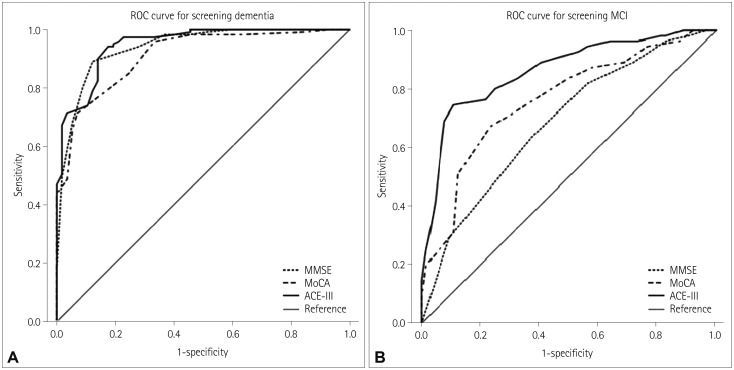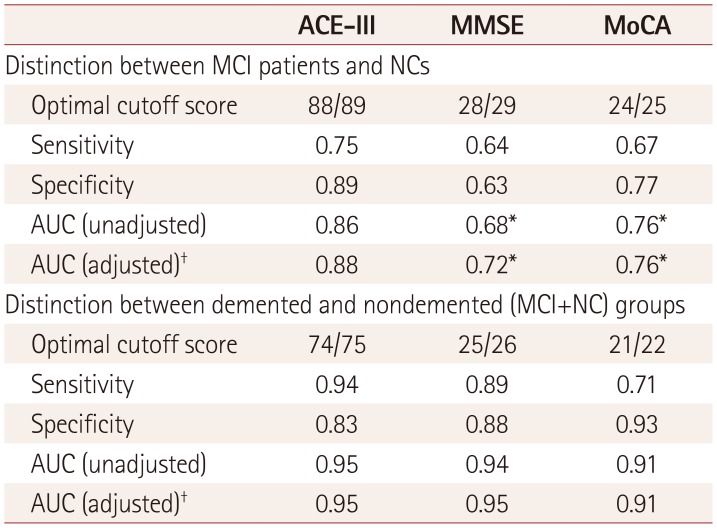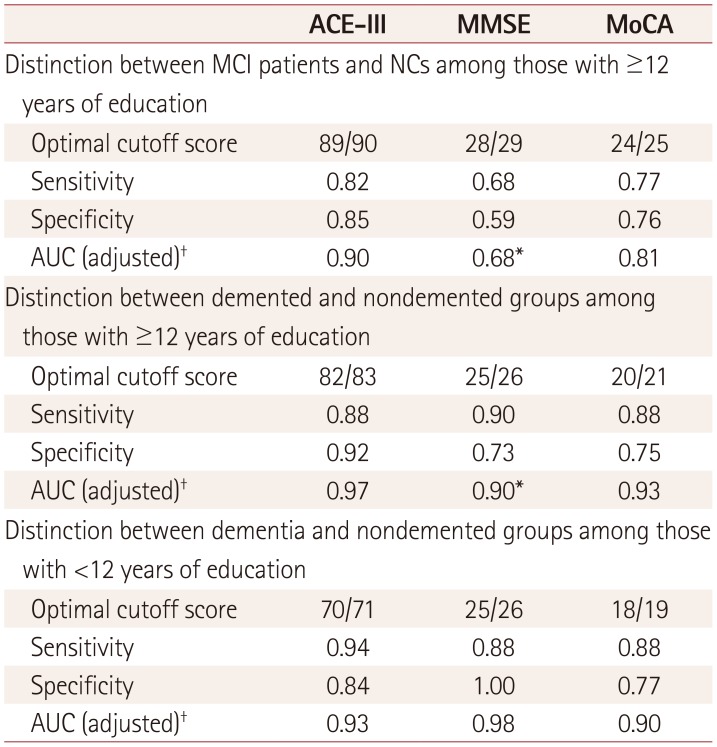1. American Psychiatric Association. Diagnostic and Statistical Manual of Mental Disorders, Fifth Edition (DSM-5). Arlington: American Psychiatric Publishing;2013. p. 602–611.
2. Kwon OY, Ahn HS, Kim HJ, Park KW. Effectiveness of cognitive behavioral therapy for caregivers of people with dementia: a systematic review and meta-analysis. J Clin Neurol. 2017; 13:394–404. PMID:
29057632.

3. Petersen RC, Smith GE, Waring SC, Ivnik RJ, Tangalos EG, Kokmen E. Mild cognitive impairment: clinical characterization and outcome. Arch Neurol. 1999; 56:303–308. PMID:
10190820.
4. Petersen RC. Mild cognitive impairment as a diagnostic entity. J Intern Med. 2004; 256:183–194. PMID:
15324362.

5. Brodziak A, Wolińska A, Kołat E, Różyk-Myrta A. Guidelines for prevention and treatment of cognitive impairment in the elderly. Med Sci Monit. 2015; 21:585–597. PMID:
25708246.

6. Lee J, Choi BH, Oh E, Sohn EH, Lee AY. Treatment of Alzheimer's disease with repetitive transcranial magnetic stimulation combined with cognitive training: a prospective, randomized, double-blind, placebo-controlled study. J Clin Neurol. 2016; 12:57–64. PMID:
26365021.

7. Folstein MF, Folstein SE, McHugh PR. “Mini-mental state.” A practical method for grading the cognitive state of patients for the clinician. J Psychiatr Res. 1975; 12:189–198. PMID:
1202204.
8. Li H, Jia J, Yang Z. Mini-mental state examination in elderly Chinese: a population-based normative study. J Alzheimers Dis. 2016; 53:487–496. PMID:
27163822.

9. Markwick A, Zamboni G, De Jager CA. Profiles of cognitive subtest impairment in the Montreal cognitive assessment (MoCA) in a research cohort with normal mini-mental state examination (MMSE) scores. J Clin Exp Neuropsychol. 2012; 34:750–757. PMID:
22468719.

10. Mitchell AJ. A meta-analysis of the accuracy of the mini-mental state examination in the detection of dementia and mild cognitive impairment. J Psychiatr Res. 2009; 43:411–431. PMID:
18579155.

11. Smith T, Gildeh N, Holmes C. The Montreal cognitive assessment: validity and utility in a memory clinic setting. Can J Psychiatry. 2007; 52:329–332. PMID:
17542384.

12. Lu J, Li D, Li F, Zhou A, Wang F, Zuo X, et al. Montreal cognitive assessment in detecting cognitive impairment in Chinese elderly individuals: a population-based study. J Geriatr Psychiatry Neurol. 2011; 24:184–190. PMID:
22228824.

13. Yu J, Li J, Huang X. The Beijing version of the Montreal cognitive assessment as a brief screening tool for mild cognitive impairment: a community-based study. BMC Psychiatry. 2012; 12:156. PMID:
23009126.

14. Hsieh S, Schubert S, Hoon C, Mioshi E, Hodges JR. Validation of the Addenbrooke's cognitive examination III in frontotemporal dementia and Alzheimer's disease. Dement Geriatr Cogn Disord. 2013; 36:242–250. PMID:
23949210.

15. Elamin M, Holloway G, Bak TH, Pal S. The utility of the Addenbrooke's cognitive examination version three in early-onset dementia. Dement Geriatr Cogn Disord. 2016; 41:9–15. PMID:
26473749.

16. Matias-Guiu JA, Fernández de Bobadilla R, Escudero G, Pérez-Pérez J, Cortés A, Morenas-Rodríguez E, et al. Validation of the Spanish version of Addenbrooke's cognitive examination III for diagnosing dementia. Neurologia. 2015; 30:545–551. PMID:
25002342.

17. Jubb MT, Evans JJ. An investigation of the utility of the Addenbrooke's cognitive examination III in the early detection of dementia in memory clinic patients aged over 75 years. Dement Geriatr Cogn Disord. 2015; 40:222–232. PMID:
26227172.

18. Wang BR, Ou Z, Gu XH, Wei CS, Xu J, Shi JQ. Validation of the Chinese version of Addenbrooke's cognitive examination III for diagnosing dementia. Int J Geriatr Psychiatry. 2017; 32:e173–e179. PMID:
28170114.

19. Peixoto B, Machado M, Rocha P, Macedo C, Machado A, Baeta É, et al. Validation of the Portuguese version of Addenbrooke's cognitive examination III in mild cognitive impairment and dementia. Adv Clin Exp Med. 2018; 27:781–786. PMID:
29790690.

20. Pigliautile M, Chiesi F, Stablum F, Rossetti S, Primi C, Chiloiro D, et al. Italian version and normative data of Addenbrooke's Cognitive Examination III. Int Psychogeriatr. 2019; 31:241–249. PMID:
30021668.

21. Lim WS, Chong MS, Sahadevan S. Utility of the clinical dementia rating in Asian populations. Clin Med Res. 2007; 5:61–70. PMID:
17456836.

22. Kempler D, Teng EL, Taussig M, Dick MB. The common objects memory test (COMT): a simple test with cross-cultural applicability. J Int Neuropsychol Soc. 2010; 16:537–545. PMID:
20188016.

23. Fang R, Wang G, Huang Y, Zhuang JP, Tang HD, Wang Y, et al. Validation of the Chinese version of Addenbrooke's cognitive examination-revised for screening mild Alzheimer's disease and mild cognitive impairment. Dement Geriatr Cogn Disord. 2014; 37:223–231. PMID:
24193223.

24. Yoshida H, Terada S, Honda H, Kishimoto Y, Takeda N, Oshima E, et al. Validation of the revised Addenbrooke's cognitive examination (ACE-R) for detecting mild cognitive impairment and dementia in a Japanese population. Int Psychogeriatr. 2012; 24:28–37. PMID:
21843399.

25. Matias-Guiu JA, Cortés-Martínez A, Valles-Salgado M, Rognoni T, Fernández-Matarrubia M, Moreno-Ramos T, et al. Addenbrooke's cognitive examination III: diagnostic utility for mild cognitive impairment and dementia and correlation with standardized neuropsychological tests. Int Psychogeriatr. 2017; 29:105–113. PMID:
27682860.

26. Matías-Guiu JA, Valles-Salgado M, Rognoni T, Hamre-Gil F, Moreno-Ramos T, Matías-Guiu J. Comparative diagnostic accuracy of the ACE-III, MIS, MMSE, MoCA, and RUDAS for screening of Alzheimer disease. Dement Geriatr Cogn Disord. 2017; 43:237–246. PMID:
28384640.

27. Cheung G, Clugston A, Croucher M, Malone D, Mau E, Sims A, et al. Performance of three cognitive screening tools in a sample of older New Zealanders. Int Psychogeriatr. 2015; 27:981–989. PMID:
25603424.

28. Terpening Z, Cordato NJ, Hepner IJ, Lucas SK, Lindley RI. Utility of the Addenbrooke’s cognitive examination--revised for the diagnosis of dementia syndromes. Australas J Ageing. 2011; 30:113–118. PMID:
21923703.








 PDF
PDF ePub
ePub Citation
Citation Print
Print


 XML Download
XML Download